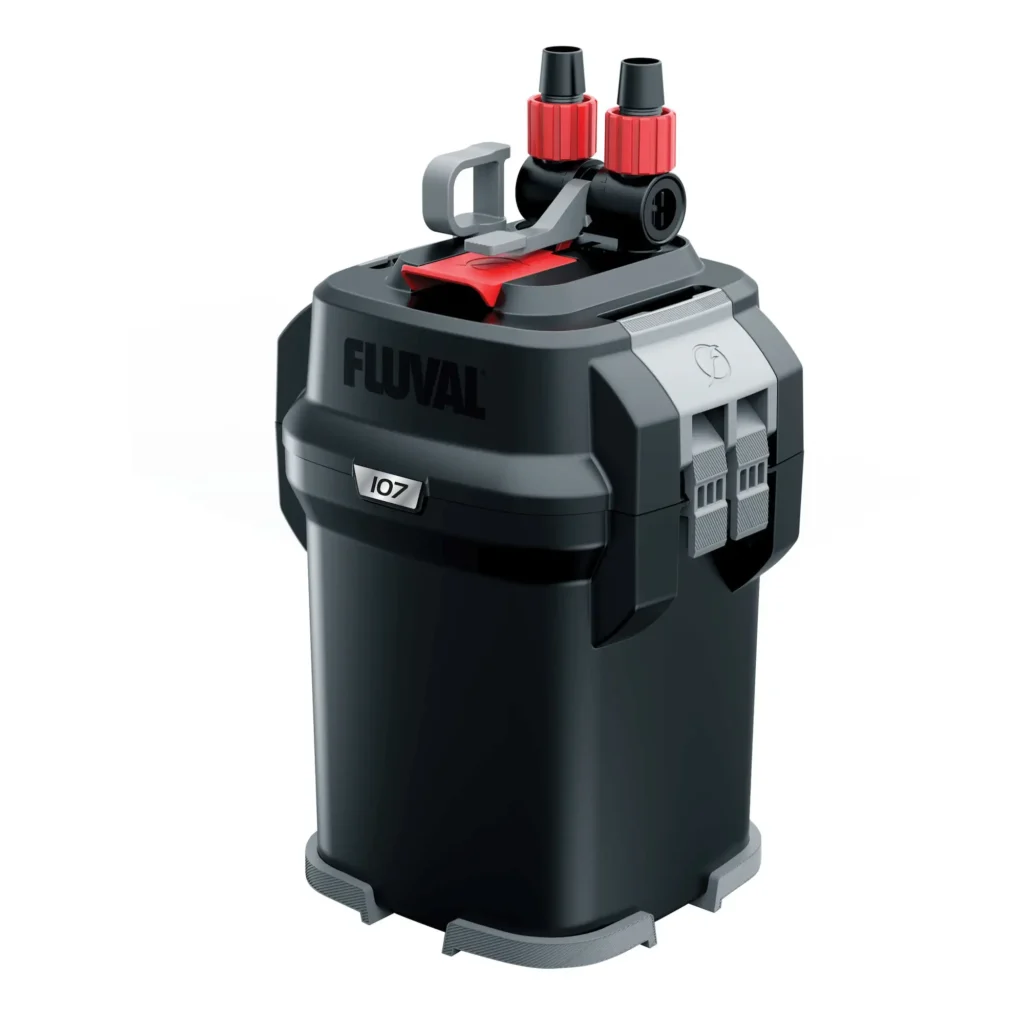When it comes to keeping angelfish in your freshwater aquarium, creating the perfect environment is crucial for their health and well-being. One of the key elements of a thriving angelfish tank is choosing the right filtration system. The best filter for angelfish is a matter of opinion, but some of the most popular and effective options include:
Canister Filters: Power and Performance
Canister filters have long been regarded as one of the top choices for angelfish enthusiasts. They offer a powerful filtration solution that can handle a significant water flow, making them ideal for larger tanks with messy fish like angelfish. These filters are known for their efficiency and versatility.
Advantages of Canister Filters
- Powerful Filtration: Canister filters are designed to handle large volumes of water efficiently. They provide excellent mechanical, chemical, and biological filtration, ensuring that your angelfish thrive in clean water.
- Easy Maintenance: Maintaining canister filters is relatively straightforward. You can replace the filter media without disassembling the entire unit, which saves time and effort.
- Customization: Canister filters allow for customization with various filter media, ensuring you can tailor the filtration process to meet your specific tank needs.
Disadvantages of Canister Filters
- Cost: Canister filters are typically more expensive than other filter types, making them a significant investment.
- Space: They require a bit of space in your tank setup due to their canister design.
Hang-on-Back (HOB) Filters: Simplicity and Space-saving
HOB filters are a great option for smaller tanks or setups with limited space. They offer an economical and straightforward filtration solution, making them a popular choice among aquarists.
Advantages of HOB Filters
- Affordability: HOB filters are often more budget-friendly than canister filters, making them an attractive choice for those starting with angelfish keeping.
- Ease of Installation: Installing HOB filters is a breeze. They are user-friendly and perfect for beginners.
- Space-saving: Their design doesn’t intrude much into the tank, which is beneficial for smaller setups.
Disadvantages of HOB Filters
- Limited Capacity: HOB filters may not be as effective as canister filters when it comes to handling large volumes of water or tanks with a heavy bioload.
Sponge Filters: Gentle Filtration for Delicate Tanks
Sponge filters are an excellent choice for small tanks or setups with fry or delicate fish. They offer gentle, yet effective filtration that won’t harm your angelfish.
Advantages of Sponge Filters
- Gentle Filtration: The soft filtration provided by sponge filters is perfect for protecting your delicate angelfish.
- Affordability: These filters are among the most budget-friendly options available.
- Ease of Maintenance: Keeping sponge filters clean and in good working condition is a simple task.
Disadvantages of Sponge Filters
- Limited Capacity: Sponge filters may not be as efficient as canister filters when it comes to handling large bioloads or maintaining pristine water quality in larger tanks.
No matter which type of filter you choose, the best filter for your angelfish tank will depend on the size of your tank, the number of fish you have, and your budget. If you’re new to the world of aquariums, it’s wise to consult with an experienced aquarist to get their recommendations.
Top Filter Models for Angelfish Tanks
Here are some specific filter models that have gained popularity among angelfish keepers:
Canister Filters:
- Fluval FX6
- Eheim Classic 350
- Oase FiltoSmart Thermo 300
HOB Filters:
- AquaClear 110
- Marineland Penguin 350
- Fluval AquaClear 70
Sponge Filters:
- Aqua-Tech Sponge Filter 10
- Aquarium Co-Op Sponge Filter Large
- Hygger Sponge Filter 300 GPH
No matter which filter you select, it is essential to ensure that it is the right size for your tank and that you clean and maintain it regularly. Maintaining consistent water quality is crucial for the health and happiness of your angelfish.
How to choose a Angelfish tank filter based on tank size
Choosing the right filter for your aquarium is essential for maintaining a healthy and thriving environment for your angelfish. One of the critical factors to consider when selecting a filter is the size of your tank. The filter’s capacity must match the tank size to ensure effective filtration. Here’s how to choose a filter based on your tank size:
Small Tanks (Up to 20 Gallons)
For tanks with a capacity of up to 20 gallons, such as nano tanks and small desktop aquariums, you have a few suitable filter options:
1. Sponge Filter:
Advantages:
- Gentle filtration, ideal for small or delicate fish.
- Low cost and easy maintenance.
- Minimal impact on water flow, preventing strong currents.
Considerations:
- Limited bioload capacity, not suitable for heavily stocked tanks.
- May not provide sufficient mechanical and chemical filtration.
2. Hang-on-Back (HOB) Filter:
Advantages:
- Compact and easy to install.
- Provides decent mechanical and chemical filtration.
- Suitable for small to moderately stocked tanks.
Considerations:
- Limited space for filter media.
- May need more frequent maintenance.
Medium Tanks (20-50 Gallons)
Tanks within the range of 20 to 50 gallons offer more filtration options:
1. Canister Filter:
Advantages:
- Excellent mechanical, chemical, and biological filtration.
- Ideal for larger tanks and moderately heavy bioloads.
- Customizable filter media for specific needs.
Considerations:
- Can be expensive.
- Requires more space and may be challenging to hide in the tank.
2. HOB Filter:
Advantages:
- Easy to install and maintain.
- Adequate filtration for medium-sized tanks.
- Available in various sizes and capacities.
Considerations:
- May not handle very heavy bioloads effectively.
- Limited space for filter media.
3. Internal or Submersible Filter:
Advantages:
- Compact design that doesn’t detract from tank aesthetics.
- Suitable for moderate bioloads.
- Often equipped with built-in heaters for temperature control.
Considerations:
- May require frequent cleaning in larger tanks.
- Limited space for filter media.
Large Tanks (Over 50 Gallons)
For tanks exceeding 50 gallons, your filtration needs become more critical due to the larger water volume and potential for heavier bioloads:
1. Canister Filter:
Advantages:
- Ideal for large tanks with significant water volume.
- Superior mechanical, chemical, and biological filtration.
- Customizable and capable of handling heavy bioloads.
Considerations:
- Higher initial cost and maintenance.
- Requires space for installation.
2. Sump Filtration System:
Advantages:
- Extremely effective and versatile.
- Can accommodate various types of filtration equipment, including skimmers, reactors, and heaters.
- Suitable for very large tanks.
Considerations:
- Complex setup and maintenance.
- Requires a dedicated sump area below the tank.
In all cases, it’s crucial to select a filter that matches your tank’s size and bioload. Overfiltration is generally a good practice, as it provides a buffer against water quality issues. Regular maintenance, such as cleaning filter media and monitoring water parameters, is vital to ensure your filter functions optimally and keeps your angelfish healthy.
How to choose a filter based on water volume
Calculating the appropriate filter size for your aquarium is crucial to ensure efficient filtration and maintain optimal water quality. To determine the filter size you need based on the gallons per hour (GPH) flow rate, follow these steps:
- Determine Tank Size and Bioload: Start by calculating the total volume of water in your aquarium. This is typically measured in gallons (G). Additionally, consider the bioload, which includes the number and size of fish, as well as any other factors contributing to waste production (e.g., plants, uneaten food).
- Determine Desired Turnover Rate: The turnover rate is the number of times the total water volume in your aquarium passes through the filter per hour. It’s recommended to achieve a turnover rate of 4 to 10 times per hour for freshwater aquariums and 10 to 20 times per hour for saltwater aquariums. The desired turnover rate can vary depending on the specific needs of your tank.
- Calculate Required Flow Rate: To calculate the required flow rate (GPH) for your filter, multiply the total water volume in your aquarium (in gallons) by the desired turnover rate: Required GPH = Tank Size (in gallons) x Turnover Rate (times per hour) For example, if you have a 50-gallon freshwater aquarium and you aim for a turnover rate of 6 times per hour: Required GPH = 50 gallons x 6 = 300 GPH In this case, you would need a filter with a flow rate of at least 300 GPH to maintain proper filtration.
- Consider Other Factors: Keep in mind that factors such as the type of fish, plants, and specific filtration needs may affect the required GPH. For example, heavily stocked or messy fish may require a higher turnover rate to maintain water quality.
- Choose a Suitable Filter: Once you’ve determined the required GPH for your aquarium, choose a filter that matches or exceeds this flow rate. Most filter manufacturers provide information about the GPH rating for their filters, making it easier to find the right one for your needs.
- Customize Filter Media: In addition to GPH, consider the filter’s media capacity and flexibility. Ensure that the chosen filter allows you to customize the filter media to address the specific filtration needs of your tank, such as mechanical, chemical, and biological filtration.
- Maintenance and Monitoring: Regardless of the filter size and GPH, regular maintenance is essential. Clean and replace filter media as needed, and monitor water parameters to ensure that your filter is functioning effectively.
By following these steps and taking into account the specific requirements of your aquarium, you can select an appropriately sized filter with the right GPH to maintain a clean and healthy environment for your fish and aquatic life.











